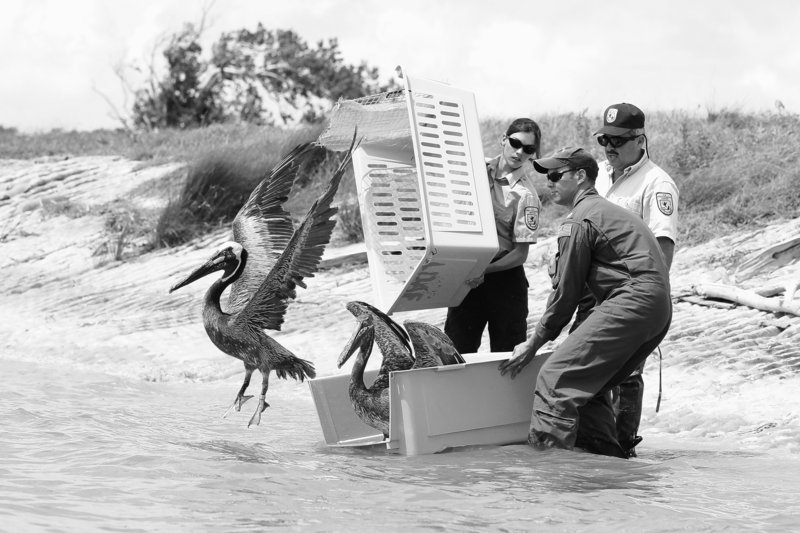NEW ORLEANS — Oil had spewed uncontrolled into the Gulf of Mexico for much of the day Wednesday before engineers reattached a cap being used to contain the gusher and direct some of the crude to a surface ship.
The logistics coordinator onboard the Discoverer Enterpriser, the ship that has been siphoning the oil, told The Associated Press that after more than 10 hours, the system was again collecting the crude. The crew member, speaking from the bridge of the ship, said the cap was placed back on the gusher around 8 p.m. CDT. He asked not to be identified by name because he was not authorized to provide the information.
BP later confirmed the cap was back in place, but said it had been hooked up about an hour and half earlier. The coordinator said it would take a little time for the system to “get ramped back up.”
Most recently, the system, which has been in place since June 4, was sucking up about 29,000 gallons an hour, crude that spewed back into the Gulf on Wednesday unabated. At that rate, it could mean about 290,000 extra gallons escaped into the water before the system restarted. Another ship was still collecting a smaller amount of oil and burning it on the surface.
BP engineers removed the cap after the mishap because fluid seemed to be leaking, creating a possible safety hazard because of the flames above, and they were concerned ice-like crystals might clog it.
The latest problem with the nine-week effort to stop the gusher came as thick pools of oil washed up on Pensacola Beach in Florida and the Obama administration sought to resurrect a six-month moratorium on deep-water drilling.
In court papers, the Justice Department said it has asked a judge to delay a court ruling by U.S. District Judge Martin Feldman in New Orleans that overturned the moratorium. The Interior Department imposed it last month after the disaster, halting approval of any new permits for deep-water projects and suspending drilling on 33 exploratory wells.
Under the worst-case scenario, as much as 104,000 gallons an hour – 2.5 million gallons a day – is flowing from the site where the offshore rig Deepwater Horizon exploded April 20, killing 11 workers.
Bob Dudley, the BP managing director who took over the spill response from his company’s embattled CEO Wednesday, had said earlier that engineers expected to replace the cap in less than a day.
“It’s a disruption, and the crew again did exactly the right thing because they were concerned about safety,” he said. “It’s a setback, and now we will go back into operation and show how this technology can work.”
When the robot bumped into the equipment just before 10 a.m., gas rose through a vent that carries warm water down to prevent ice-like crystals from forming in the machinery, Coast Guard Adm. Thad Allen said.
In May, a similar problem doomed the effort to put a bigger containment device over the blown-out well. BP had to abandon the four-story box after the crystals clogged it, threatening to make it float away.
The smaller cap had worked until now. To get it to the seafloor, though, crews had to slice away a section of the leaking pipe, meaning the flow of oil could be stronger now than before.
Meanwhile, pools of oil washed up along miles of national park and Pensacola Beach shoreline and health advisories against swimming and fishing in the once-pristine waters were extended for 33 miles east from the Alabama border.
“It’s pretty ugly, there’s no question about it,” Gov. Charlie Crist said.
The oil had a chemical stench as it baked in the afternoon heat. The beach looked as if it had been paved with a 6-foot-wide ribbon of asphalt, much different from the tar balls that washed up two weeks earlier.
“This used to be a place where you could come and forget about all your cares in the world,” said Nancy Berry, who watched her two grandsons play in the sand far from the shore.
Park rangers in the Gulf Islands National Seashore helped to rescue an oily young dolphin found beached in the sand.
The Obama administration was plotting its next steps Wednesday on the drilling halt. Interior Secretary Ken Salazar said that within the next few days he would issue a new order imposing a moratorium that eliminates any doubt it is needed and appropriate.
Attorneys for the oilfield services companies that sued over the moratorium filed court papers accusing the Obama administration of ignoring Feldman’s decision. They said Salazar’s comments about a new moratorium have had a chilling effect on the resumption of drilling.
Several companies, including Shell, said they would await the outcome of any appeals before they start drilling again.
Send questions/comments to the editors.



Success. Please wait for the page to reload. If the page does not reload within 5 seconds, please refresh the page.
Enter your email and password to access comments.
Hi, to comment on stories you must . This profile is in addition to your subscription and website login.
Already have a commenting profile? .
Invalid username/password.
Please check your email to confirm and complete your registration.
Only subscribers are eligible to post comments. Please subscribe or login first for digital access. Here’s why.
Use the form below to reset your password. When you've submitted your account email, we will send an email with a reset code.